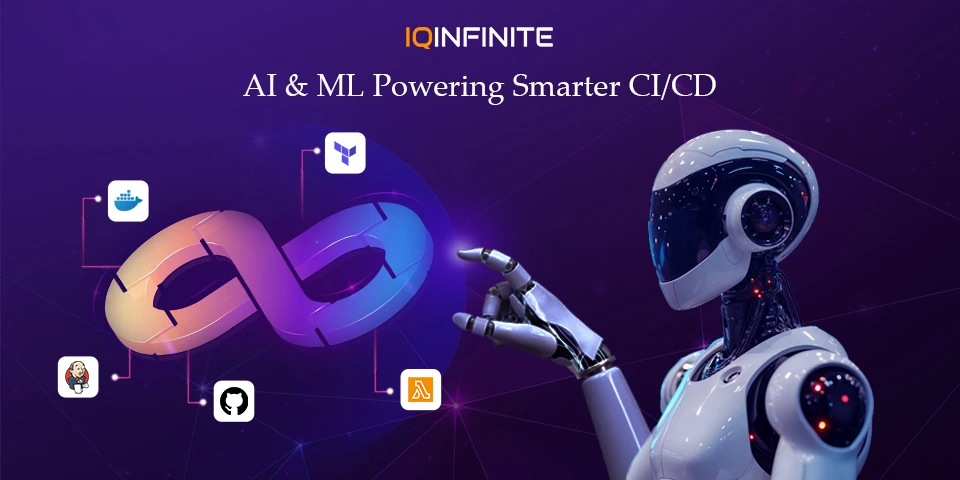AI-Enhanced DevOps: How Machine Learning is Reinventing CI/CD Pipelines

In today’s hyper-competitive software landscape, speed and reliability are no longer optional they’re the lifeblood of modern development. DevOps emerged as the response to this pressure, breaking down silos between development and operations teams, automating delivery pipelines and enabling rapid, repeatable deployments.
But even DevOps is now hitting its limits.
As applications scale in complexity and release cycles shrink from months to weeks or even days, we’re entering a new era. Traditional CI/CD pipelines are struggling to keep up. Enter: Machine Learning (ML) and Artificial Intelligence (AI) not as buzzwords, but as practical tools reinventing the way we build, test and deploy software.
We’ll explore how AI is not only enhancing DevOps, but fundamentally reshaping CI/CD pipelines to be smarter, faster and more resilient.
What Is AI-Enhanced DevOps, Really?
Think of it as giving your DevOps pipeline the ability to learn, adapt and improve over time. Here’s what that really means in practice:
- Learning from past patterns: ML models can analyze historical build, deployment and incident data to identify recurring trends and issues helping teams avoid past mistakes.
- Identifying anomalies early: Instead of waiting for a failure to escalate, AI can catch subtle signs of trouble (e.g., performance degradation, flaky tests, abnormal metrics) long before they become major incidents.
- Predicting outcomes before execution: AI can forecast whether a particular code change is likely to cause test failures or deployment risks, allowing teams to take preventive action.
- Optimizing build and test processes: By intelligently selecting which tests to run or which components to rebuild, AI can significantly reduce CI/CD cycle times and save compute resources.
- Making smarter, data-driven decisions: From prioritizing issues to deciding whether a rollback is needed, AI enables teams to act based on real-time data and predictive insights not just gut instinct.
Where Machine Learning Supercharges CI/CD
Here’s how ML is reshaping Continuous Integration and Continuous Delivery:
1. Predictive Build Optimization
Machine learning models can analyze code changes and historical build data to intelligently predict which parts of the CI/CD pipeline are likely to fail or which tests are truly relevant. Instead of running the entire test suite, the system selectively runs only the necessary components significantly reducing build times, resource consumption and overall compute costs.
2. Anomaly Detection
With thousands of metrics streaming from logs, tests and monitoring tools, subtle issues can easily go unnoticed. Machine learning models excel at identifying patterns and can detect anomalies in test outcomes, performance metrics or infrastructure behavior often catching problems long before they become visible to human engineers.
3. Flaky Test Identification
Flaky tests those that fail intermittently without code changes undermine confidence in automated testing and slow down development. Machine learning can analyze historical test runs to identify patterns of flaky behavior, enabling teams to isolate, prioritize and fix unreliable tests with data-driven precision.
4. Release Risk Assessment
By analyzing historical incidents and deployment data, machine learning models can assign a risk score to each new release. This proactive insight alerts teams when a deployment resembles patterns associated with past failures offering a critical opportunity to investigate and mitigate potential issues before going live.
5. Intelligent Rollbacks
Modern platforms are leveraging machine learning to automate rollback decisions. By continuously monitoring key metrics such as latency, error rates and user behavior ML models can detect deviations from expected patterns in real time. When anomalies are detected, the system can automatically flag the issue or trigger a rollback, minimizing user impact and reducing the need for manual intervention.
The Future: Autonomous Pipelines?
Picture this:
- Your pipeline proactively suggests optimizations based on historical data.
- It flags risky code changes before they even reach the main branch.
- It can self-heal common issues without manual intervention.
- It guides developers on which tests to prioritize next for maximum impact.
Conclusion
If you’re managing a modern CI/CD system, exploring where ML can add value is no longer optional it’s essential. Start small, perhaps by optimizing test runs or implementing anomaly detection and gradually expand your AI capabilities. The goal isn’t to replace engineers but to empower them with actionable, intelligent insights that enhance their productivity and decision-making.
As DevOps continues to evolve, teams that embrace AI won’t just accelerate their delivery they’ll fundamentally transform how they innovate and respond to challenges, moving faster and smarter.
